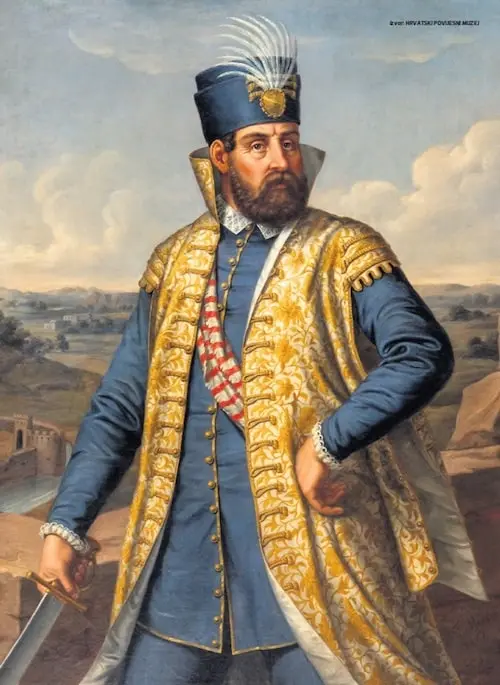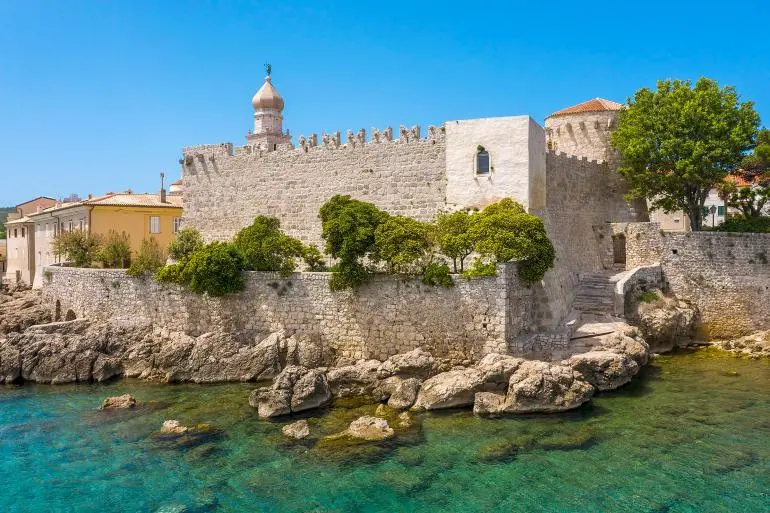The Frankopan Dynasty: Architects of Krk island’s Golden Age
Table of Contents
The Frankopan family, also known as the Frangipani in Italian, stands as one of the most illustrious and influential noble families in Croatian history. Their extensive political, cultural, and economic contributions left a lasting impact on Krk, Croatia and the wider region. The Frankopan family’s legacy spans several centuries, beginning in the medieval period on the island of Krk and extending into the early modern era.
Origins of the Frankopan family on Krk and their rise to prominence
The Frankopan family traces its origins to the island of Krk in the Adriatic Sea. Their name is believed to have derived from the Latin phrase “franco pane,” meaning “free bread,” symbolizing their generosity and the relief they provided to the poor. Their ancestry can be dated back to the 12th century when Dujam I Frankopan was granted the title of Count of Krk by the Venetian Republic. This title marked the beginning of the family’s rise to prominence.
The Frankopans’ strategic control of Krk, situated along important maritime routes, allowed them to amass wealth and influence. They skillfully navigated the complex political landscape of the time, forging alliances with various powers, including the Kingdom of Hungary and the Republic of Venice.
Expansion of Influence
The Frankopan family expanded their domains beyond Krk, acquiring lands on the mainland. Their territories included regions such as Modruš, Vinodol, and Senj. The family’s influence reached its zenith in the 15th century when they controlled extensive lands in Croatia and parts of Bosnia and Herzegovina.

Key Figures
Several members of the Frankopan family played pivotal roles in Croatian and regional history:
- Nikola IV Frankopan (1360-1432): A prominent statesman and diplomat, Nikola IV was instrumental in the Croatian-Hungarian kingdom. He acted as a mediator between the king and other noble families, strengthening the family’s political influence.
- Ivan VI Frankopan (1455-1523): Known for his resistance against the Ottoman Empire, Ivan VI defended Croatian territories during the Ottoman incursions. His efforts were crucial in protecting the region from further Ottoman expansion.
- Fran Krsto Frankopan (1643-1671): A notable poet and politician, Fran Krsto is remembered for his involvement in the Zrinski-Frankopan conspiracy against the Habsburgs. His execution marked the end of the family’s direct influence.
Decline and Legacy
The Frankopan family’s decline began in the 16th century due to internal conflicts, external threats from the Ottoman Empire, and shifting political alliances. The execution of Fran Krsto Frankopan in 1671, following the failed conspiracy against the Habsburgs, marked the end of their direct influence. However, their legacy endures through the numerous cultural and historical landmarks associated with their name.
The influence of the Frankopan family on the island of Krk
The Frankopan family’s connection to Krk began in the 12th century and is still present today. Under the Frankopan rule, Krk became an essential administrative and political center. The family fortified the island, constructing defensive structures and expanding their territorial control to safeguard against external threats, including piracy and rival noble factions. Their governance was characterized by a blend of local autonomy and allegiance to larger political entities such as the Venetian Republic and the Kingdom of Hungary.
Key Contributions to Governance
- Administrative Reforms: The Frankopans implemented various administrative reforms that improved local governance and economic management. They established efficient systems for tax collection, legal adjudication, and land management, fostering stability and prosperity on the island.
- Military Defense: Recognizing the strategic importance of Krk, the Frankopans invested heavily in fortifications and military infrastructure. They built and reinforced castles, watchtowers, and city walls, ensuring the island’s defense against invasions and raids.

Economic Development
The Frankopan family played a crucial role in the economic development of Krk. Their policies and initiatives helped transform the island into a thriving economic hub.
Maritime Trade and Commerce
Krk’s location made it an ideal center for maritime trade. The Frankopans capitalized on this by promoting and regulating trade activities. They established ports and shipyards, facilitating the movement of goods and fostering economic exchanges with other Adriatic and Mediterranean ports. The family’s influence extended to securing safe passage for merchants and protecting trade routes from piracy.
Agricultural Advancements
The Frankopans also contributed to the agricultural development of Krk. They implemented land reforms and introduced advanced farming techniques, enhancing agricultural productivity. The cultivation of olives, grapes, and other crops flourished under their patronage, leading to the production of high-quality olive oil and wine, commodities that became important trade goods.
Cultural and Religious Influence
The Frankopans were not only political and economic leaders but also patrons of culture and religion. Their support for the arts, education, and religious institutions significantly enriched the cultural landscape of Krk.
Promotion of the Glagolitic Script
The Frankopans were ardent supporters of the Glagolitic script, the oldest known Slavic alphabet. They promoted its use in religious and official documents, helping preserve and propagate the Croatian language and cultural identity. The Church of St. Lucy in Jurandvor, home to the Baška tablet, is a prime example of their dedication to the Glagolitic tradition.
Support for Education and the Arts
The Frankopan family fostered education and the arts by supporting local scholars, artists, and craftsmen. They established schools and libraries, contributing to the intellectual and artistic growth of the island. Their patronage attracted talented individuals to Krk, further enhancing its cultural vibrancy.
Main historical attractions on Krk island connected to the Frankopan family
The Frankopans invested in the construction and renovation of numerous religious and civic buildings on Krk. Here are the main attractions on Krk that are related to the Frankopan family:
Frankopan Castle in Krk Town
Location: Krk Old Town
The Frankopan Castle, located in the heart of Krk Town, is one of the most significant landmarks on the island. Built in the 12th century, the castle served as the primary residence and administrative center of the Frankopan family. The castle is a fine example of medieval architecture and features:
- Fortifications: The castle’s robust walls and towers were designed to defend against invasions and attacks.
- Museum: Today, the castle houses a museum that displays artifacts and exhibits related to the history of the Frankopan family and the island of Krk. Visitors can explore various rooms, including the armory, dungeons, and residential quarters.
- Events: The castle is also a venue for cultural events, such as concerts, exhibitions, and medieval-themed festivals, which bring history to life for visitors.

Cathedral of the Assumption
Location: Adjacent to Frankopan Castle, Krk Town
The Cathedral of the Assumption, situated next to the Frankopan Castle, is another important site connected to the Frankopan family. The cathedral has a long history dating back to the 5th century, but it was significantly expanded and renovated under the patronage of the Frankopans. Key features include:
- Architectural Styles: The cathedral showcases a blend of Romanesque and Gothic architectural elements.
- Frankopan Tombs: Several members of the Frankopan family are buried within the cathedral, making it a site of great historical and genealogical interest.
- Bell Tower: The cathedral’s bell tower offers panoramic views of Krk Town and its surroundings.
Košljun Island Monastery
Location: Near Punat, accessible by boat
The Franciscan monastery on Košljun Island, founded by the Frankopan family in the 15th century, is a serene and spiritual retreat. The monastery is situated on a small island in the bay of Punat and is known for its peaceful atmosphere and rich history. Highlights include:
- Museum Collections: The monastery houses a museum with collections of religious artifacts, manuscripts, and artworks. Notable items include rare books, ethnographic exhibits, and archaeological findings.
- Nature and Gardens: The island’s well-tended gardens and natural surroundings offer a tranquil setting for reflection and exploration.
- Cultural Events: The monastery hosts occasional concerts and cultural events, enhancing its role as a cultural center.
Church of St. Lucy in Jurandvor
Location: Jurandvor, near Baška
The Church of St. Lucy in Jurandvor is renowned for the Baška tablet, a significant Glagolitic inscription dating back to the 12th century. The church itself is a modest Romanesque structure, but its historical importance is immense due to:
- Baška Tablet: The tablet is one of the oldest known records of the Croatian language and uses the Glagolitic script. It provides valuable insights into the linguistic and cultural history of the region.
- Frankopan Patronage: The Frankopan family’s support for the church and the Glagolitic tradition highlights their role in preserving Croatian cultural heritage.

Town of Vrbnik
Location: Eastern coast of Krk
The picturesque town of Vrbnik, perched on a cliff overlooking the Adriatic Sea, was one of the key strongholds of the Frankopan family. Vrbnik is famous for its narrow streets, medieval architecture, and wine production. Key attractions include:
- Medieval Architecture: The town’s layout and buildings reflect its medieval origins and the Frankopan influence.
- Church of the Assumption: This church, with its impressive interior and historical significance, is another example of the Frankopans’ religious patronage.
- Žlahtina Wine: Vrbnik is renowned for its Žlahtina wine, an indigenous variety. The Frankopans played a role in developing the local viticulture, and today visitors can enjoy wine tasting in the town’s cellars.
Gradec Castle
Location: Near villages Risika and Garica
- History: Gradec Castle, also known as Rovoznik Fortress, is a medieval fortress, dating back to the 12th century. It was constructed by the Frankopan family, as a center of their military, political and administrative rule. The castle’s strategic position on a hilltop provided excellent defensive capabilities and commanding views of the surrounding area.
- Today: Although now in ruins, the remnants of Gradec Castle offer a fascinating glimpse into the island’s feudal past and the architectural prowess of the Frankopans. Visitors to the site can explore the remains of the fortress walls and imagine the historical events that once unfolded in this impressive stronghold.
Other Notable Sites
Location: Various locations on Krk
Several other sites on Krk bear the mark of the Frankopan family:
- Dobrinj: This inland village features historical buildings and churches linked to the Frankopans. The Parish Church of St. Stephen is particularly noteworthy.
- Šilo: This coastal village offers beautiful views and remnants of Frankopan-era structures.
- Omišalj: With its strategic location, Omišalj was another important site during the Frankopan era. The Church of the Assumption of the Blessed Virgin Mary in Omišalj is a notable landmark.
Enduring Legacy
The Frankopan family’s influence on Krk endured even after their decline in the 17th century. The architectural and cultural landmarks they established continue to draw visitors and scholars, preserving their legacy and the island’s historical significance.
Today, Krk stands as a testament to the Frankopans’ enduring impact. The island’s rich cultural heritage, vibrant economic history, and well-preserved historical sites reflect the profound contributions of one of Croatia’s most storied noble families. Exploring these sites provides valuable insights into the Frankopan family’s pivotal role in shaping the history and development of the island of Krk.
If you need help organising your activities or booking the best tours to explore the island and it’s surrounding, feel free to contact us. And if you need a place to stay, check out our selection of accommodation on the island of Krk.